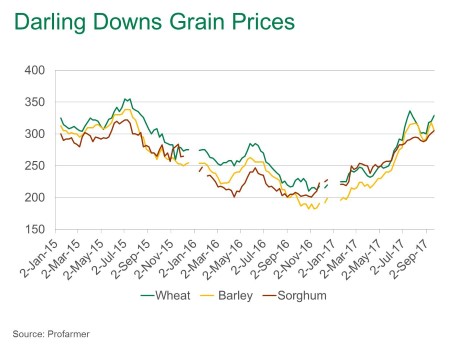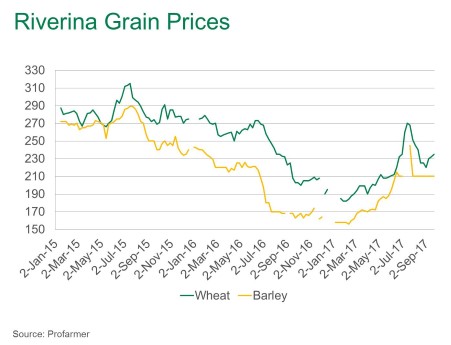Gains for Grains
Australian crop production is forecast to fall in 2017/18 (ABARES Agricultural Commodities Report September 2017) after a record season in 2016/17, and grain prices are on the rise back toward 2015 levels. In fact, prices during September reached the highest levels since mid-2015.
Darling Downs
Average prices for wheat and sorghum ex-Darling Downs increased by 3% and 2% from August, respectively, while barley prices remained steady (Profarmer). However, when compared to the low prices of January, the significant recovery that grain prices have made is more evident. Wheat prices averaged $316.75/tonne, up 41%, while barley averaged $305.75, up 54% and sorghum averaged $298.25, lifting 35% from the beginning of the year. The Bureau of Meteorology (BOM) outlook for the remainder of spring forecasts average rainfall, however the dry conditions experienced throughout the planting season across much of the region affected planting area, with smaller areas able to be planted. As a result crops are reportedly suffering severe moisture stress – contributing to a growing lack of supply. Consequently, prices lifted, however many will be unable to take advantage of the price premiums with lower yields.

Riverina
Prices in the Riverina are have also been supported by diminishing supply following poor seasonal conditions and in the wake of a bumper crop last year – however to a lesser extent than in the Darling Downs. Wheat prices eased slightly from August, averaging $229.25, back 2%. Barley remained steady at $210/tonne. Comparable to the Darling Downs however is the jump in prices from the beginning of the year, with grain prices ex-Riverina up 25% for wheat and 33% for barley.

For the lotfeeding sector, falling grain prices somewhat offset some of the gains made by feeder cattle prices from mid-2015 onwards. However, given the current dry condition, the dynamic is reversing. Cattle prices have been easing for some months now, passing a significant cross-roads in June where supply and price surpassed year-ago levels for the first time in three years, albeit in opposite directions. Meanwhile the same poor seasonal conditions have resulted in grain prices recovering as production is impacted, supporting prices.



